Diving Ambergris Caye: The Best of Belize
The warm breeze of the Caribbean Sea warmed my skin as I sipped on a cool glass of Belikin beer, awaiting the ferry to Ambergris Caye. This is a place I visited many years before and had been in love with since my first step on the island. Belize is home to some of the largest Mayan ruins in Central America, with several sites hidden in the jungle throughout the country. It is also home to the Belize barrier reef system and the Great Blue Hole. On this trip, we would get to visit both, something I had never done before.
The official language of Belize is English, making it a popular place for Canadians, Americans and Brits. An unspoiled paradise in Central America it has managed to avoid the devastation from over-tourism for many years, making it a truly authentic Caribbean experience.
Before we dive into Belize’s Blue Hole, I want to share that I am including affiliate links in this post. Transparency is important to me, and I hope you know that I only include products and services I truly believe in and recommend. If you make a purchase through these links, I may earn a small commission at no cost to you.

Ambergris Caye and surrounding areas
There are two ways to visit the island of Ambergris Caye: by small plane or by ferry. Flights are operated every hour by Maya Island Air or Tropic Air, usually around $150 each way. Make sure you check both airlines for prices and availability. If you don’t like small planes or just want to save some money, a water taxi is a great option. At just $18 to Ambergris Caye, it is quite a steal. The Belize Water Taxi offers water taxi service to most of the islands in Belize and even Chetemul near Tulum.
To reach the ferry terminal, you can take a taxi from Belize City International Airport to the port downtown, which takes about 20 minutes. Getting to Ambergris Caye takes about 2.5 hours on the double-decker water taxi.

Ferries boarding passengers in Belize City
Feeling a bit under the weather I was hoping for a sunny and comfortable spot on the ferry to rest on our way out to sea. Packed to the brim with people, supplies, and some pets ,we got seats in the back where the breeze could keep us cool. As we pulled out from the port, I watched the birds dancing in the wind.
Past mangrove forests and the last remaining houses, we motored into the blue waters of the Caribbean Sea, the gentle hum of the motors rocking me to sleep. I awoke as we pulled into the island of Caye Caulker, a sleepy island popular with backpackers and budget travelers, just down the coast from Ambergris Caye.
It’s filled with colorful houses and hotels that remind me of a Caribbean version of Burano in Italy. Dropping off people and supplies, we were quickly on our way to Ambergris Caye.
Ambergris Caye is the largest island in Belize and also the most popular place for tourists to visit. From the island, it is easy to explore any number of surrounding islands and take mainland day tours to Mayan ruins, cave tubing, butterfly gardens and much more. They can all be booked from the island as well.
The island is 25 miles long and just a mere 1.6 miles wide at its widest point. We arrived into San Pedro—the only town on the island and hub for food, accommodations, and activities.
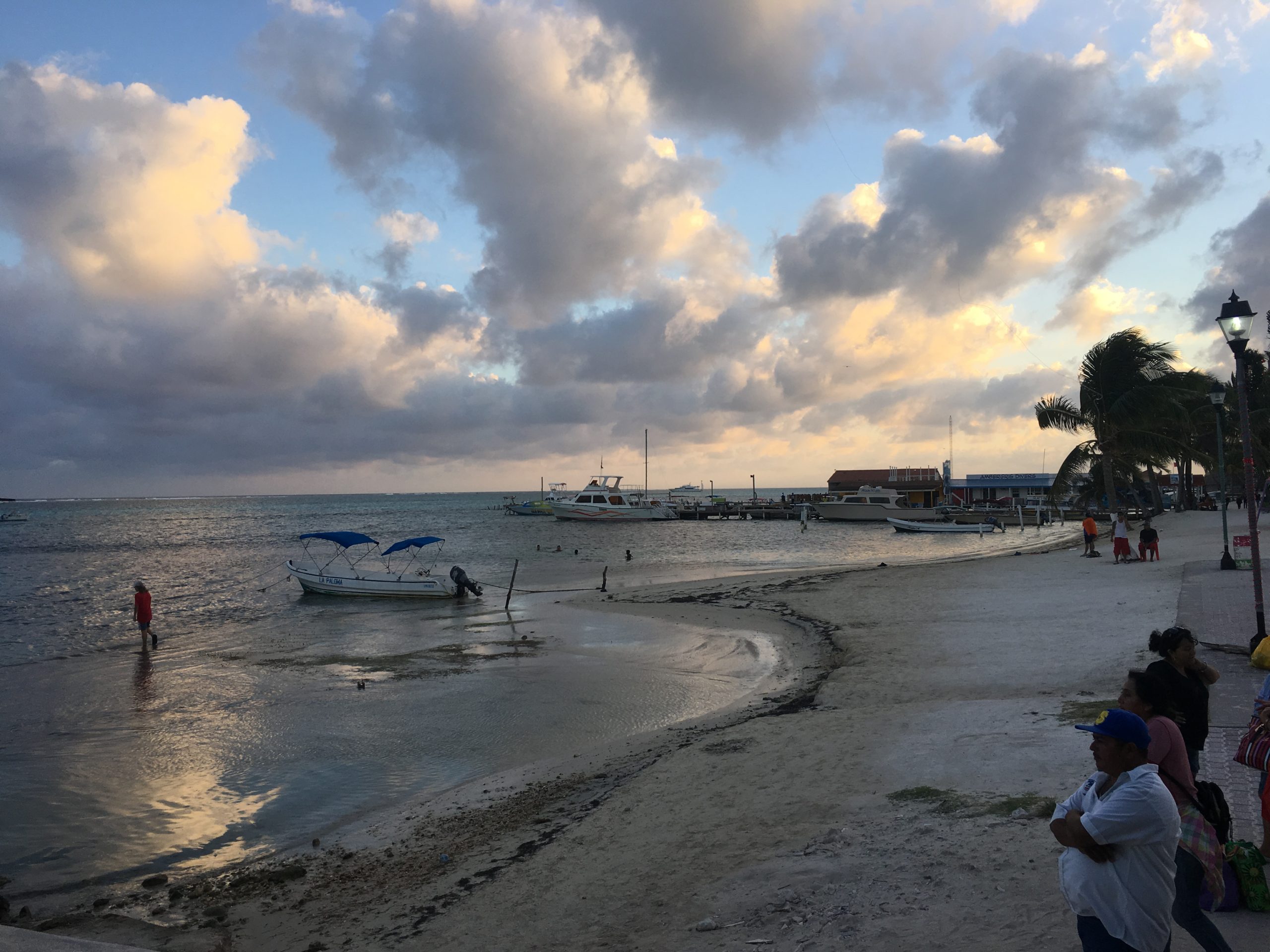
Exploring San Pedro Town
Most of the businesses and hotels are located around San Pedro Town. Due to the island’s small size, the main options for transport are golf carts and boats. A small number of cars are on the island, but all are sequestered to the town of San Pedro. Many people talk about these islands as the Caribbean of 40 years ago—a throwback to the days before cruise ships, duty-free shops, and discount jewelry.
You won’t find any chain stores or big brands in Ambergris Caye or its surrounding islands. If you are looking for a great place to stay in town, Ramon’s is a great option. The best hotel beach in town, it has palapas right on the beach, as well as a bar and restaurant where you can even grill your own meat on the tabletop. If diving is on your agenda, you will love their onsite diving center. This is where you can rent everything and plan the perfect day out exploring the miles of reef.
San Pedro town has a plethora of restaurants from budget to luxurious. Make sure you try El Fogon and Elvi’s Kitchen, two of the oldest and most authentic restaurants on the island. Some other favorites are Wild Mangoes, Blue Water Grill, and Palmilla. Farther up island, Mambo and the Rojo Lounge at Matachica, as well as Capricorn are great choices.
Fabulous hotels aside, the real reason I was coming back was diving Ambergris Caye. Belize is home to the second-largest barrier reef system in the world that stretches from the Yucatan south and covers more than 240 miles. Ambergris Caye is bordered by an atoll that is part of this reef system, protecting it from rough seas and large predators. The close proximity of the atoll makes for some of the best snorkeling and diving you can find anywhere in the Caribbean.

Belize Barrier Reef from above
One of the best ways to see the reef system and the island is by plane. From the airport in San Pedro, there are scheduled daily outings to see the Blue Hole around 11 on both Maya Island Air and Tropic Air. Missing both, we decided on chartering a plane for about $600 for two of us and headed out towards the Great Blue Hole—about 40 miles from the island.
The Great Blue Hole is the largest sunken cave system in the world. Once above the sea, it was engulfed by a rising ocean more than 15,000 years ago. These rising waters would have degraded its roof system that one day collapsed, creating a hole some 1,000 feet across and 407 feet deep. Flying there, we passed over the barrier reef, dozens of islands and atolls, and miles of open ocean. It was beautiful departing the island.
It wasn’t long before we saw the Blue Hole, a true abnormality named by Jacques Cousteau in 1971. It is a World Heritage Site and one of the top 5 scuba diving sites in the world.
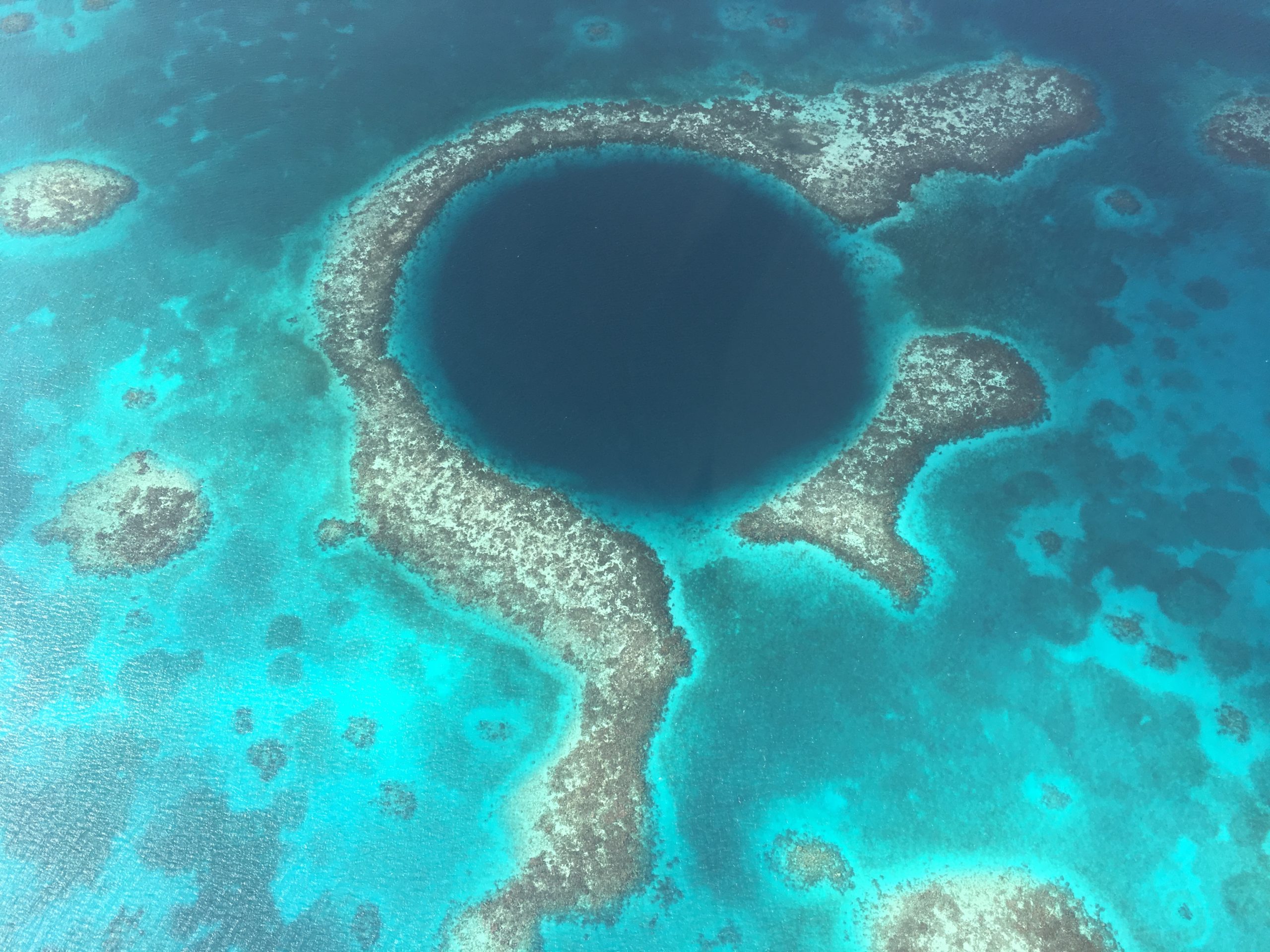
Belize Great Blue Hole : Alice’s Adventures
Snorkeling & Scuba Diving Ambergris Caye
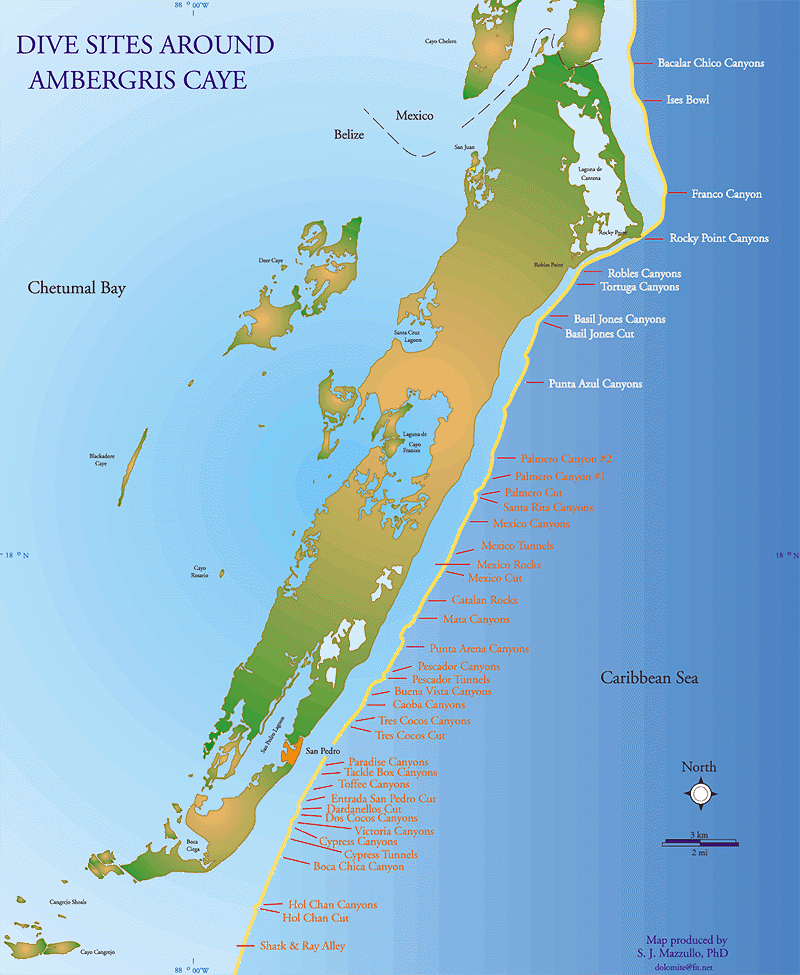
There are 40 snorkeling/dive sites less than a mile from the coast of the island. The most popular are Hol Chan, Shark & Ray Alley to the south, and Mexico Rocks to the center. The northern end of the island is great for macro photography, but all the sites offer an amazing amount of marine life.
A variety of soft and hard corals and many different species of swimming and crawling marine life such as the Nassau Grouper, Angel Fish, Lobster and the Stone Crab, as well as turtles, small sharks, eels and rays can be found here. With yearly average temperatures around 80F, one can stay in the water exploring most of the day.

Our first morning, we headed out with Chocolate, our onsite diving guide, to snorkel at Mexico Rocks. Within a moment of jumping in, Andrew came fin to face with a nurse shark. His first encounter with a shark—lucky for him it was a nurse shark, “the puppy dogs of the sea.” Not one to panic, I was surprised by how calm and collected he remained.
I jumped in after him and swam around, just following our new friend. Before long, we were joined by a sea turtle, who was all too curious in investigating us. The shallow reef was home to dozens of lobsters and hundreds of fish, and the corals were healthy—a rare sight these days. It was emanating with vibrant colors and other life. A stingray came to wish us well as we departed back to the boat.

Diving the Great Blue Hole
After seeing the Blue Hole from the sky, it was time to explore its depths from below. Trips to the Blue Hole are full days tours and are available for both open/advanced divers and snorkelers. Divers must have dove in the last 6 months in order to be eligible for diving at depths near 150’. There are not tours out to the Blue Hole everyday so make sure you plan your excursion at the beginning of your trip in case availability changes.
We went out with Amigos del Mar, but there are a few different companies that offer trips. Divers cost $260 and snorkelers cost $195. These prices included 3 dives or snorkels and a visit to Half Moon Caye Natural Monument with meals. Trips start early in the morning, which means your trip out to sea will be chasing the rising the sun.
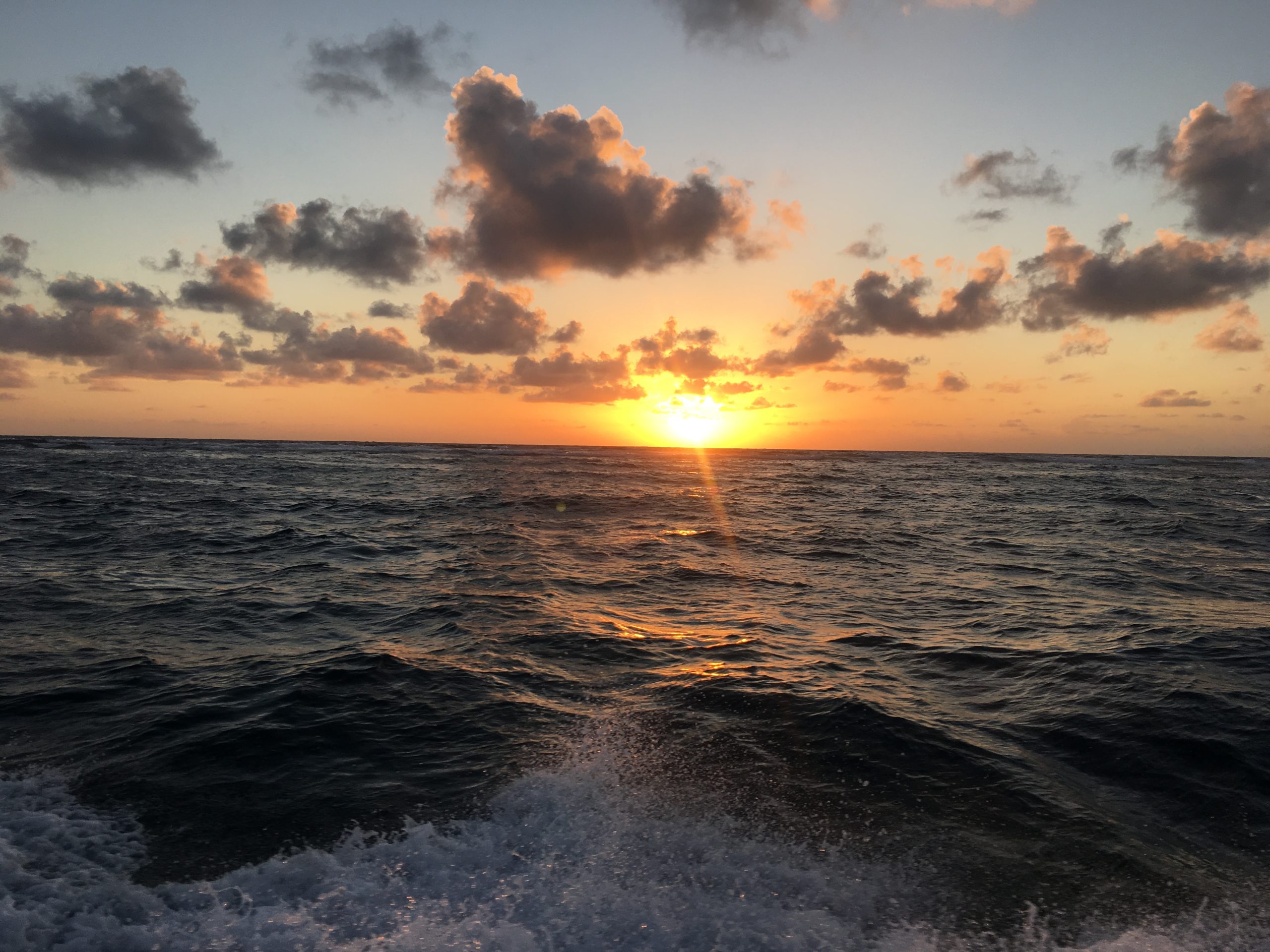
The trip out to the Blue Hole takes several hours. We passed many different islands and headed for the rougher waters of the sea as we got farther from shore. By the time we reached the Blue Hole, it was a wonderful sunny day. Donning our gear, those of us that were diving jumped in the water, while the snorkelers waited eagerly to explore the shallower waters.
The Blue Hole is made of limestone and the shallower depths are full of corals with a sandy white bottom. This abnormality of nature is unlike anything I have ever seen underwater before.
Our group of divers descended slowly so that everyone could equalize with the pressure. At around 60′ deep, the sandy bottom slowly drops off and down a cliff. We hung to the sandy wall for another 20′ as the sunlight started to fade. We were soon in utter darkness.
With the beam of the flashlights to follow, we descended still further into the depths. At 140′, the wall curves back and we entered the remnants of what would have once been a huge cavern. Stalactites hung all around us from the ceiling of this ancient limestone cavern.
We had just 7 short minutes to look at these alien formations far under the ocean surface. Looking farther into the middle of the abyss, we could make out some big sharks enjoying the cooler waters of the deep. With just one entrance and exit, the animals that find their way into the hole often spend a lifetime there.
Soon enough, we were heading back to the surface to decompress. While I was diving, Andrew had been snorkeling in the shallower waters with small fish and corals. The trip included three tanks of diving and we would be moving to a new dive location once everyone was safely back on the boat. I was excited to see some more sharks, corals, and hopefully an Eagle ray.
Dives two and three had an abundance of diverse marine life. The barrier reef has more than 60 species of hard and soft corals! The variations are so unique they are hard to describe. Some look like empty flower vases, while others look like crystallized sugar fanned out and standing up straight. There were corals that looked like tree branches and others that looked like rocks.
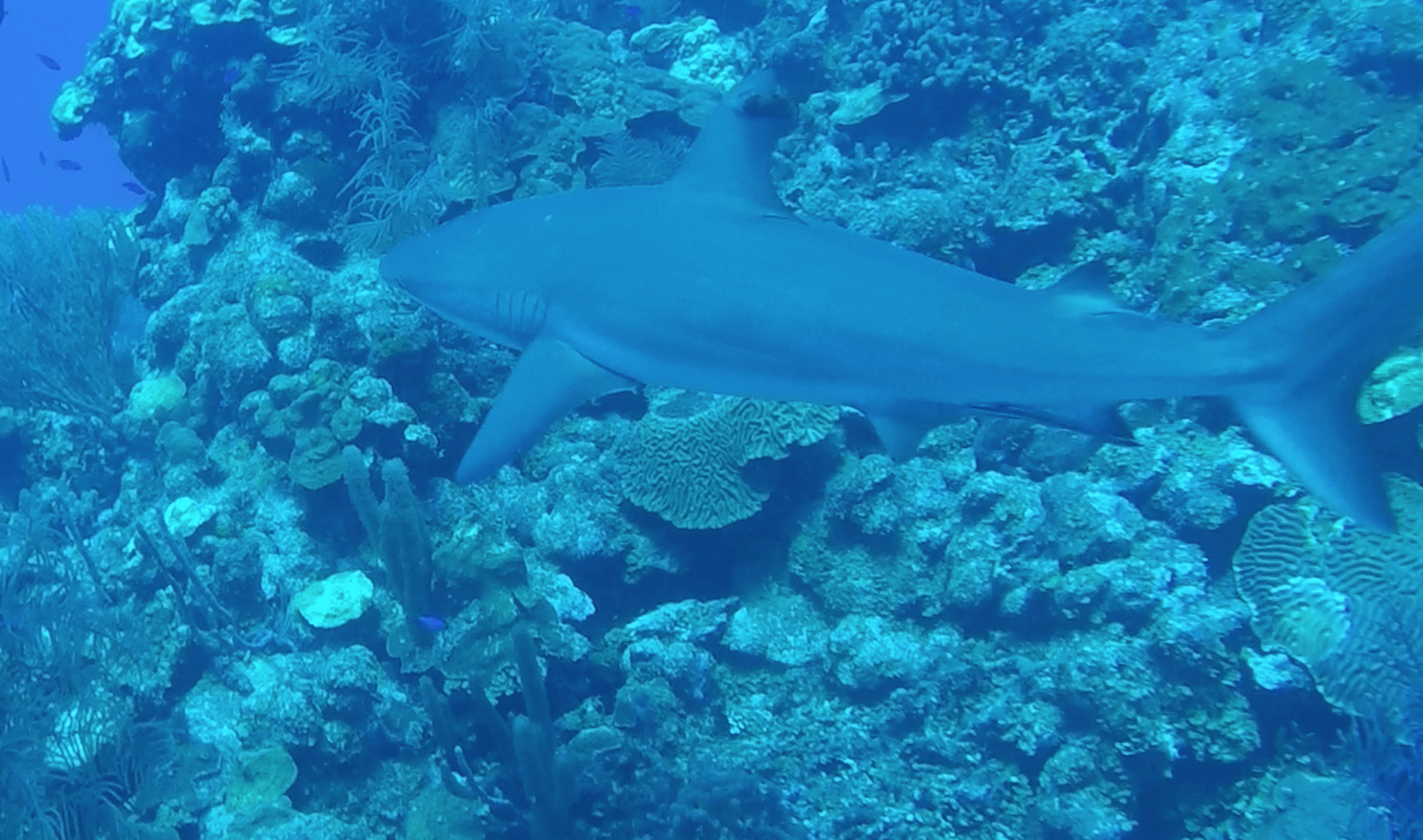
Reef Shark in the Belize barrier reef
Several Caribbean reef sharks of varying sizes cruised nearby, with the larger ones staying farther from the reef. A graceful sea turtle swam around us, looking even more peaceful in the deeper waters.
On the third dive, we dove near a wall that went down to a few hundred feet deep. Our guide suggested that we avoid swimming too close to the wall because Moray eels hide in crevasses. After getting distracted following a grouper, I got too close to the wall and was startled by the diver behind me screaming. I looked to the wall just in time to see an eel darting right for my face.
Remembering that our fins are our defense underwater, I stuck mine up and deflected this Moray from giving me a bite. Lesson learned, I paid closer attention as we continued our dive and noticed several more moray eels as we swam along.
Right before we ascended on our last dive, I was rewarded with a treat. I had read about the existence of Eagle rays in the Belize Barrier Reef, and this was a species I had never seen. To my luck, I caught a fleeting movement to my right and noticed an Eagle ray just leaving the reef. I followed him as much as I could, and now my dream for the day had been fulfilled. Eagle rays are so graceful, with huge outstretched fins that resemble wings that move quickly through the water to be able to pump oxygen through their gills.
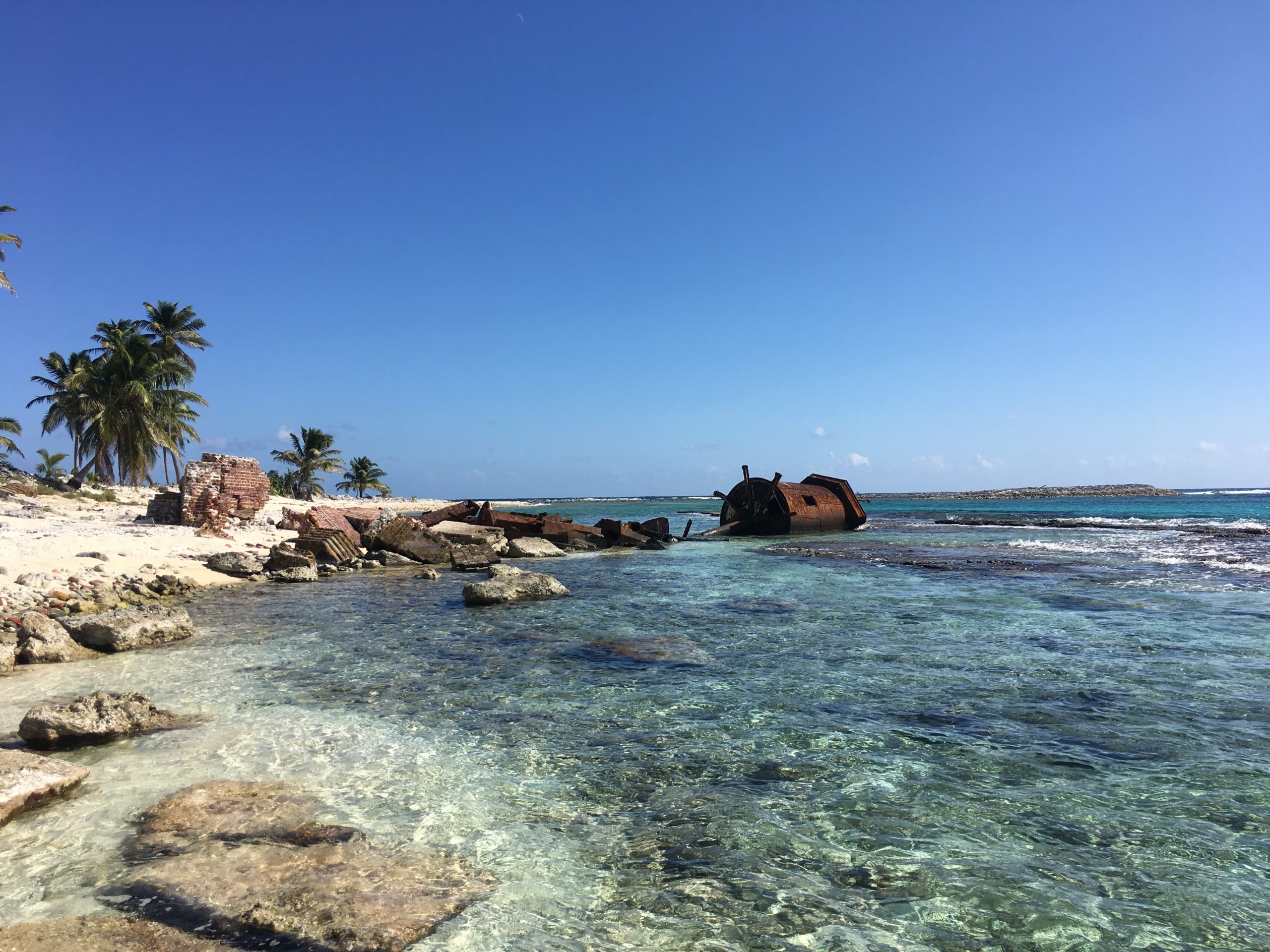
Half Moon Caye National Protected Area of Belize
Our trip to the Belize Blue hole wasn’t quite over. Our last stop would be the island of Half Moon Caye, a Belize Natural Monument. It’s a small island that is home to the largest colony of red footed boobies in the Caribbean. The island is a paradise for these birds that share it with a thriving population of geckos, iguanas, and hermit crabs. It’s protected as part of the World Heritage Site and not even a grain of sand is allowed to leave the island.
The red footed booby is a beautiful bird! The island has a viewing platform that allows you to be at the same level with their nests. Lucky for me, I was there in December, which is nesting season for the birds. Most of them were sitting in their nests protecting freshly laid eggs.
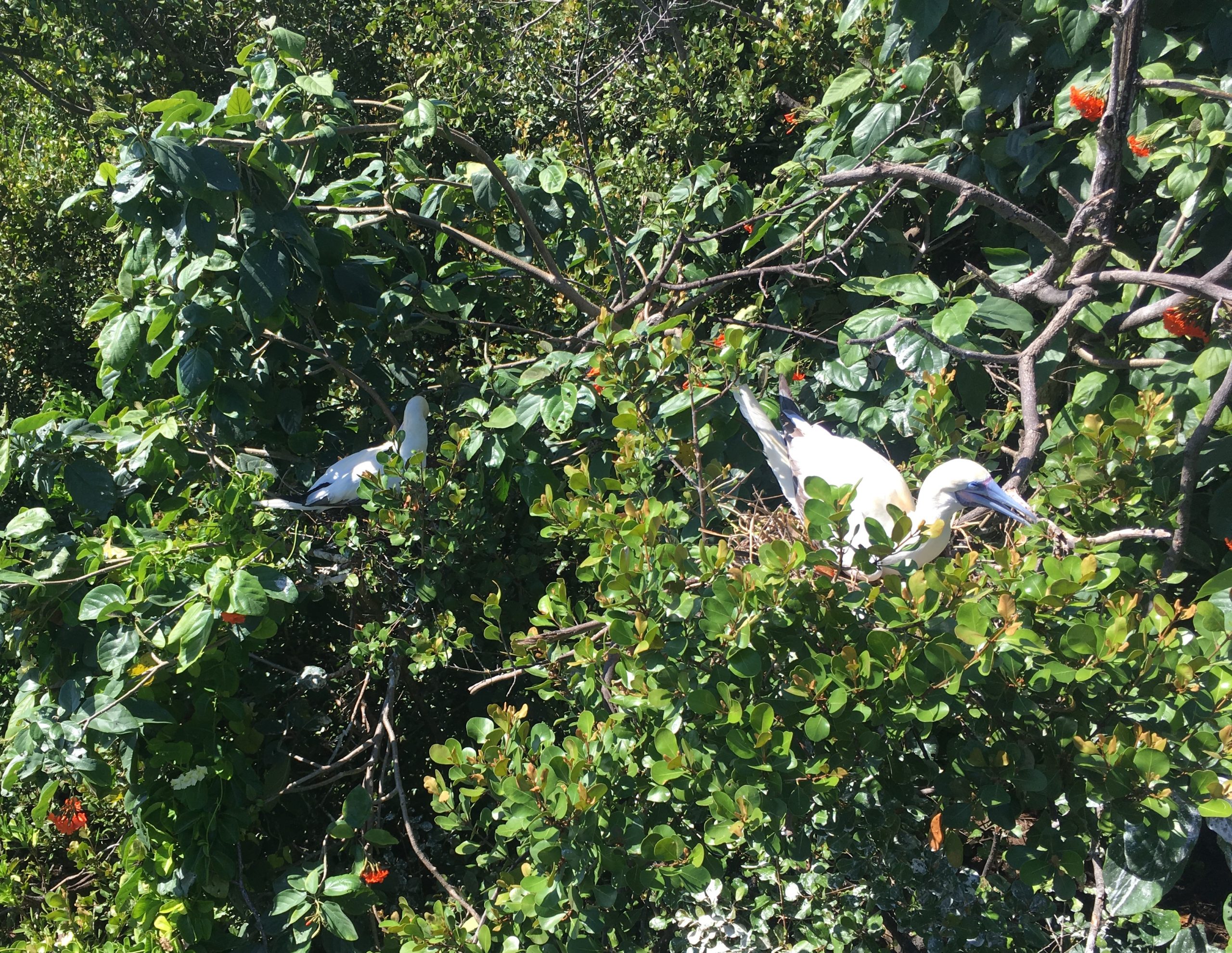
Red Footed Boobies on Half Moon Caye Belize
We were allowed to spend about an hour exploring the small island and viewing the birds before heading back to Ambergris Caye.
Want to help protect the sea and its many species? Please consider making a donation to Sea Legacy today.
Loved this article?! Share it!
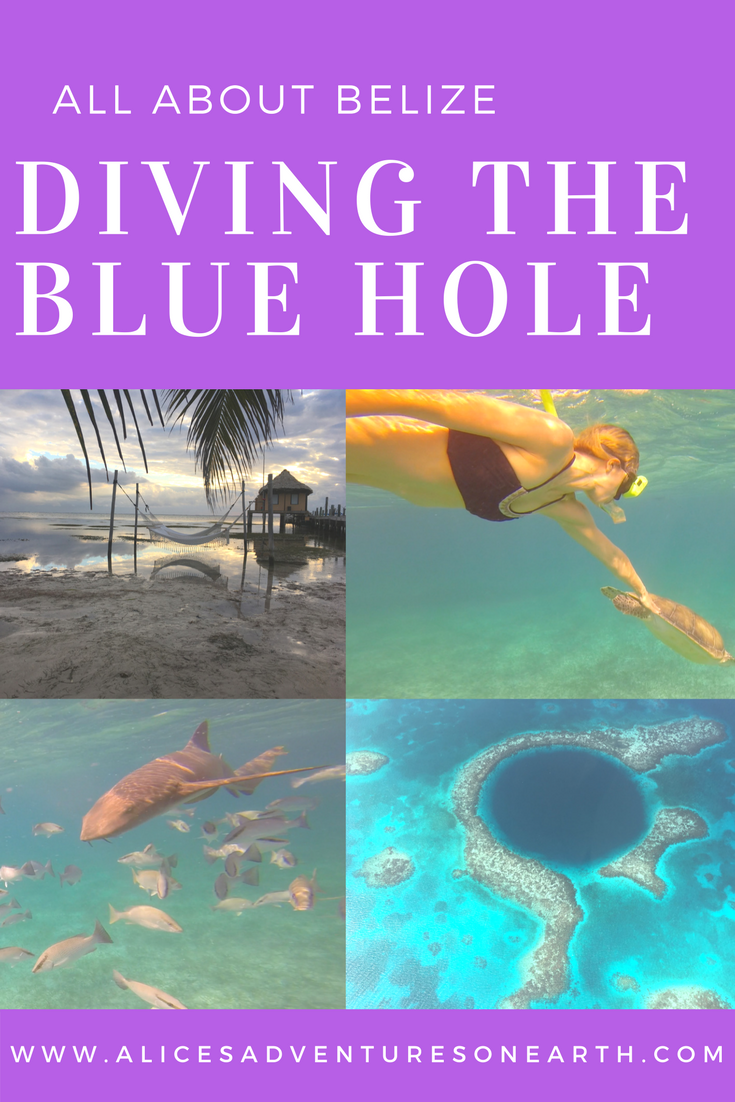
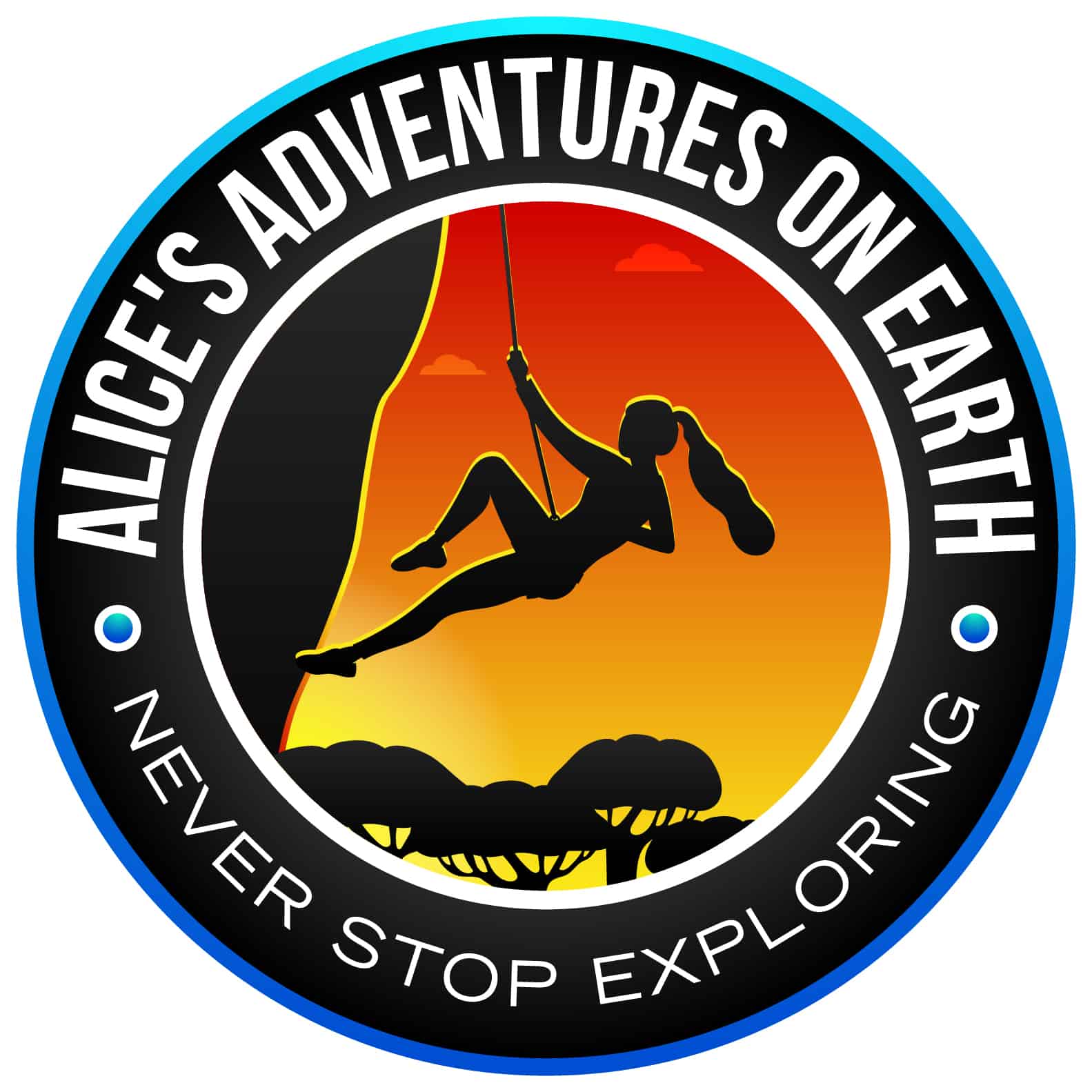



I hope that you won’t stop writing such interesting articles. I’m waiting for more of your content. It’s so good that i’m going follow you!
Thanks so much. I hope to dive in Cyprus one day
So exotic place to dive. Did you make photo of that shark? I would never do it, you are so brave!
Yes it sure is. I love it there. I did take these photos of the shark.